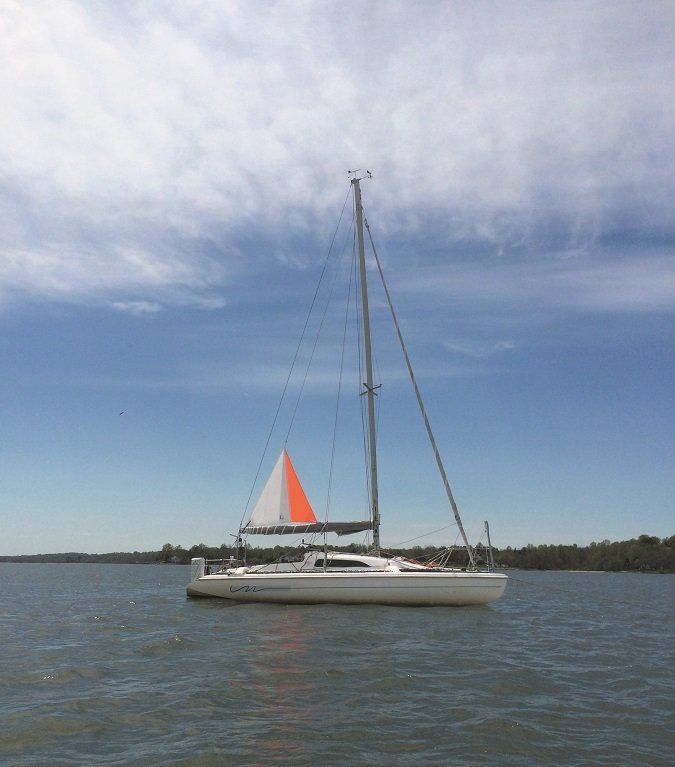
Even when your anchor is well designed and ideally matched to your boat, there are four common factors that can cause an anchor to drag: poor bottom, short scope, insufficient shock absorption, and yawing. Each of these reduces the holding capacity of the anchor, and they are additive. That is to say that any one of them can ruin your day, solving only one or two of them does not ensure good holding, and the more problems you solve, the better you’ll sleep.
In our ongoing multi-part study of anchoring with all-rope anchor rode, PS technical editor Drew Frye explores various methods to reduce yawing at anchor-a problem that can be exacerbated all-rope rode. Previously, we’ve looked at kellets (see PS May 2019), which help reduce yawing by adding increasing drag at the bow. As we saw in that report, any efforts that focus on adding drag at the bow generally become ineffective as the wind increases to above 25 knots.
The effects of a boat yawing at anchor can often go unnoticed until it is too late. Constant yawing prevents an anchor from setting deeply, and because the rode tension of a boat sailing vigorously at anchor is typically 50-100 percent greater than one resting quietly, it may cause the anchor to slowly walk downwind. Not only does this slow dragging gradually bring your boat closer to hazards astern, it also greatly increases the risk of the anchor tripping, resulting in a sudden failure.
As stronger winds overcome bow drag (chain rode, kellets, etc.), boats that rest quietly in moderate winds can begin to yaw at anchor. About 60 percent of the sailors we interviewed reported yawing 55-65 degrees in strong weather, with some reporting yaw angles as great as 120 degrees.
You can assess your boats tendency to yaw in strong winds by anchoring with all-rope rode in a steady breeze, and recording the range of compass bearings on the lubber line. This is how your boat will behave, even with chain, in a real storm.
PS reviewed the Fin Delta riding sail by Banner Bay Marine (Riding Sails to Tame those Dancing Boats, December 2007). This time we compare three designs head-to-head, focusing on yaw angles and rode tension. (See the adjacent article How We Tested, for details on the testing.)
What We Tested
We tested three designs: a traditional triangular riding sail, hoisted on the backstay and sheeted to one side at a range of angles; the Fin-Delta from Banner Bay Marine, which forms a Y-shape, promising more efficient control; and an over-the-boom sail of our own design, based on the Paratech Delta Riding Sail.
Observations
A riding sail functions both by pushing the transom back in line when the boat sails to one side, and by increasing windage at the stern, steadying the pull on the rode. Traditional one-dimensional riding sails work by encouraging the boat to rest at a slight angle to the wind. These triangular panels are rigged from the backstay and sheeted to a side cleat at a 15- to 20-degree angle to the boats centerline. This causes the boat to ride at an angle of about 10 degrees to the wind. The stabilizing force on one tack comes from the sail, and the stabilizing force on the other tack comes from the side of the boat. Because the boat generally lies to one side, the wind load is higher, even when the sail itself is aligned with the wind. Three-dimensional Y- and V-shaped riding sails, including the Fin-Delta and V-Delta, set in alignment with the boats centerline, providing a correcting force on either side when the boat yaws, as well as some steadying drag force even when aligned with the wind.
Calculating Force
To calculate wind force on a particular sail we used the formula: Force=drag coefficient x area x 0.0034 x V2. Force is stated in pounds, area is in square feet, and velocity (V) is in knots. The drag coefficient depends on shape. For a hull turned sideways, the drag coefficient will be close to 1 and the area will increase as the boat yaws. The drag coefficient for a sail will vary from very low at small angles of attack, to about 1 for a flat sail that is fully stalled and at a right angle to the wind.
Our test boat has a 700-pound rode tension at 60 knots. Calculations show that the riding sails we tested create an additional 40-60 pounds of drag when aligned with the wind. This 7- to 10-percent increase in drag is insignificant compared to the increased load created by yawing. In our tests, we were unable to measure the sails drag because the sails net impact was always less than the impact of wind gusts and wave action.
Wind striking a riding sail from the side creates more force, as much as 10-15 percent of the baseline windage. However, because the sails center of effort is higher than the hull and located at the stern of the boat, most of the strain is transferred to the keel and rudder, not the anchor rode. Thus, the increase in drag caused by the riding sail at its working angle is many times less than the increased windage of the hull and rig if the boat is allowed to swing freely.
Riding sails must be rigged as far aft as practical. They must be well aft of the keel; a deeply reefed mainsail is of little help. A reefed mizzen sail with a flattening reef will help, but this is not recommended because of added wear and tear. Riding sails must be rigged above the dodgers and bimini tops to remain in clear air. Stern cleats, often recommended for sheeting the riding sail, are sometimes located too far forward or too far inboard to work well.
Before investing in a riding sail, try to eliminate any windage forward of the keel that can contribute to the yawing. A dinghy on the foredeck is a common culprit. You might already have enough canvas aft to serve as a riding sail. That said, a riding sail is more aerodynamically efficient than a blocky dodger/bimini combination.
You can adjust the drag of V- and Y-shaped sails. To adjust drag on the V-shaped Fin Delta, you open or close the V by moving the clew position. You can adjust the Delta Riding Sail by opening or closing its inverted V or by changing the boom elevation.
We performed our tests at maximum clew spread. We varied the height of the boom when testing the Delta Riding Sail; it did not make a measurable difference, as long as the boom was at least 20 degrees above horizontal and the entire sail was above the cabin structure.
A conventional riding sail is adjusted by changing its angle relative to the lubber line. Typically it is set from the backstay to a midship cleat, but sailors have reported success rigging it to the topping lift and moving the traveler to windward. Do not rig the sail fore-aft, parallel or in line with the boats centerline. It will pop annoyingly as the wind moves from one side to the other.
Sizing a Riding Sail
Although bigger is generally better for anchors, we prefer the right size for a riding sail; it is easier to rig, stronger, and has less potential to cause mischief in a violent storm. Smaller riding sails can actually be more effective. You should also consider your needs; a boat with a high freeboard or doghouse will need more sail area, while a more streamlined boat that is relatively stable will need less.
Manufacturers will suggest the appropriate size. Our testing yielded a few rules of thumb that differed slightly from these recommendations, and can also be used:
Single Panel Area (square feet)
30-40 percent LOA (feet)
3 percent of working sail area (square feet)
V-style Area (square feet, one side only)
40-50 percent of LOA (feet)
4 percent of working sail area (square feet)
Steadying in Storm Winds
The weakness of anti-yawing strategies at the bow, including chain and kellets, is that they fail when they are needed most, when the wind really howls. A riding sail, on the other hand, works by correcting the aerodynamic balance of the boat, in both light winds and extreme weather. Do they make sense when anchored tropical storm or even hurricane conditions?
Although conventional wisdom is to strip all canvas, field reports indicate riding sails, when properly constructed and rigged, can be beneficial. Our models do not suggest there is an upper limit for their use. If they reduce yawing and reduce peak rode tension at 30 knots, they will do the same at 50 knots or even 100 knots. Balance is balance.
Unlike random bits of canvas, riding sails are small, efficient, and serve a specific purpose that does not change when the wind howls-keep the bow into the wind and provide steady back tension, reducing yawing and surging.
Are they strong enough? Conventional riding sails are clearly NOT suitable for storms. Our observations suggest they will be subject to flogging in winds over 40 knots because the leading edge is free flying. The flogging forces on the backstay can be severe.
The Fin Delta, on the other hand, has been proven in tropical storm conditions at moorings. The Fin Delta is not supported by the backstay and can be reinforced with multiple halyards. Because it sets high, it could increase heeling, something to consider if you are near other boats.
Fully supported by the boom, the Delta Riding Sail was designed with hurricane forces in mind. Its small size and low location contribute little to heel or drag, with a force that is as much downwards as to the side. The boom can be supported with multiple halyards or fixed in gallows and the sail should be built like a storm jib, using heavy cloth, triple stitching, and extra support tapes.
Dyneema sheets are a good idea, because they reduce movement and hence chafe, which is the enemy. The calculated sheet loads for the Delta Riding Sail at 60 knots and even at 100 knots are lower than those of a working jib. As for material, 8-ounce polyester cloth should be sufficient for riding sails up to about 20 square feet, adjusting upwards from there.
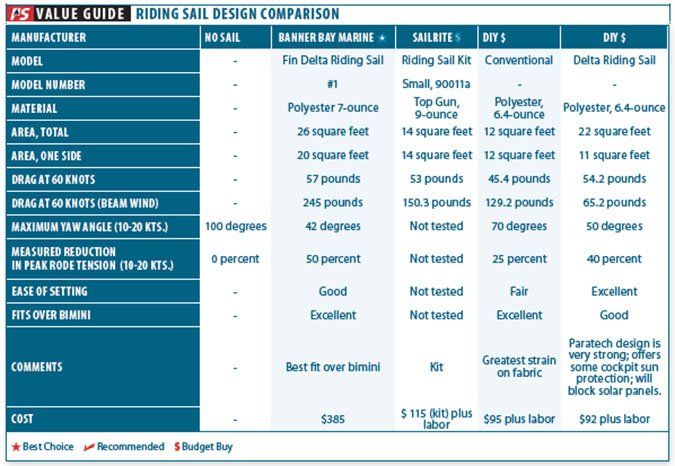
DIY Conventional Riding Sail
Our triangular test sail measured roughly 4 x 6 x 6 feet, about 12 square feet. It added no measurable windage and significantly reduced yawing. The opposite leeward side of the sail occasionally caught the wind, causing a distinct popping sound that convinced us that this sail will flog excessively in a storm.
Bottom Line: A conventional riding sail may be enough on some boats, but it is not our favorite.
Sailrite Kit (small 90011a)
Measuring about 12.5 square feet, this sail is similar to the DIY version. We expect minimal added windage and significantly reduced yawing. Instead of polyester sailcloth, it is made from UV resistant Top Gun acrylic, which will stretch more but last much longer in the sun.
Bottom Line: The kit is a good value, especially if you are handy with a sewing machine.
Banner Bay Marine Fin Delta
Banner Bays V-style riding sail has been evaluated through a NASA grant and proven in tropical storm conditions. The unique Y-design provides good stability and delivers the best correction performance.
Although the leading edge is unsupported, triangular bracing is provided by the Y sections aft, improving stability in strong winds. Although there are more lines to tweak than other riding sails, once pre-set, it takes only a few moments to set and tension. It should be easy to rig above a bimini top.
Bottom Line: We rated this Best Choice in 2007 and we see no reason to change this recommendation.
Delta Riding Sail
The Delta riding sail was developed by Paratech Engineering, maker of the Delta Drogue and parachute sea anchors, but it was never marketed. It is illustrated in their parachute sea anchor instruction manual and we interviewed the inventor about its history. We designed our own Delta sail by stretching cord to the suggested shape (see adjacent article, Another Option: Making Your Own Riding Sail).
The sail is laid over the boom, attached close to the aft end of the boom and pulled tight to the mast end. The clews are then attached to stern cleats, and the boom raised to a 20-40 degree angle using the topping lift, and reinforced by a halyard (in strong winds these are winched bar-tight to provide sheet tension). We liked that the sail could be rigged before lifting the boom to add tension.
We liked that it set quite low, minimizing heeling force if the wind came from the side. Support from the boom greatly reduces cloth stress making it very durable and stable. We also liked that it provided some cockpit protection from UV and weather, beneficial both at anchor and on a mooring.
If you carry a parachute sea anchor, we think you should carry one of these. The greatest drawback may be difficulty in rigging over a bimini, although in a strong storm, the bimini should be lowered.
Bottom Line: The simple design, ease of rigging, and effectiveness makes it our Recommended sail for storms.
Delta sail (with a SEA Anchor)
Paratech Engineering developed the Delta riding Sail to help monohull sailboats to ride more quietly to a sea anchor. In addition to the windage/foil imbalance that causes a boat to sail at anchor, boats riding to a sea anchor are moving backwards at about 0.5-1 knot.
Some of this force is neutralized by very strong winds, but there is still a strong tendency for boats to lie to one side, sometimes alternating back and forth. One recommended solution is to stabilize the boat to one side with a bridle, as described in the book Storm Tactics by Lin and Larry Pardey. Sea anchor maker Fiorentino has further refined the technique.
Another approach is to use a larger parachute and really stop the boat. This works better for multihulls, since they are stable on a bridle and not stable or comfortable when hove to. However, during the lulls after a wave passes, the rode will recoil and try to pull the boat forward, depending on the conditions. There can be near-slack moments when the bow can fall off, resulting in yawing and increased force. Slack in the rode increases fatigue, and this can be catastrophic if the boat is spun beam-to the sea. The sea anchor rode should have as little slack as possible.
Bottom line: A properly sized and ruggedly-built V-riding sail will help keep the boat on a sea anchor bow-to in a storm-either at anchor or while using a sea anchor. Additionally, the riding sail will provide a little pull astern, steadying the boat by reducing slack. If you are considering a sea anchor, a V-style riding sail should be part of your kit.
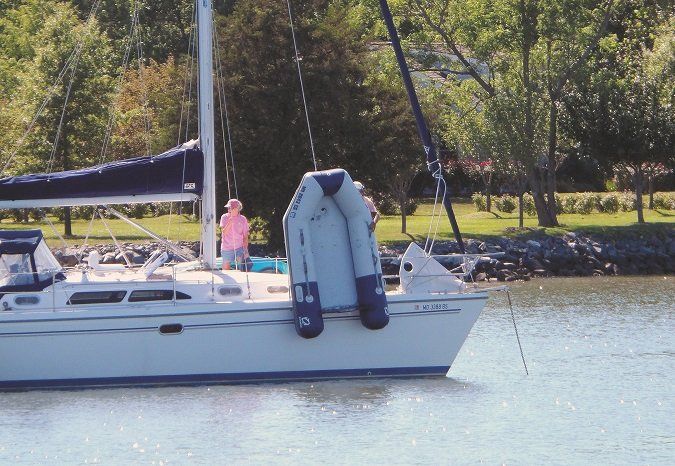
Conclusions
A conventional riding sail will reduce mild yawing, but its effectiveness is limited and wed not use it in storm force winds. Its 19th century technology.
The Fin Delta provides maximum yaw control in a stable, quiet package. The Delta Riding Sail is slightly less efficient in yawing reduction and may not work with a large bimini, but it has bullet-proof durability and simplicity on its side.
We see two applications. If you anchor with rope rode, or if your boat wont stay bow to the wind, these will settle your boat down, even in a moderate blow. We also think riding sails can be a useful aid in storm conditions, where holding the anchor steady is enormously important.
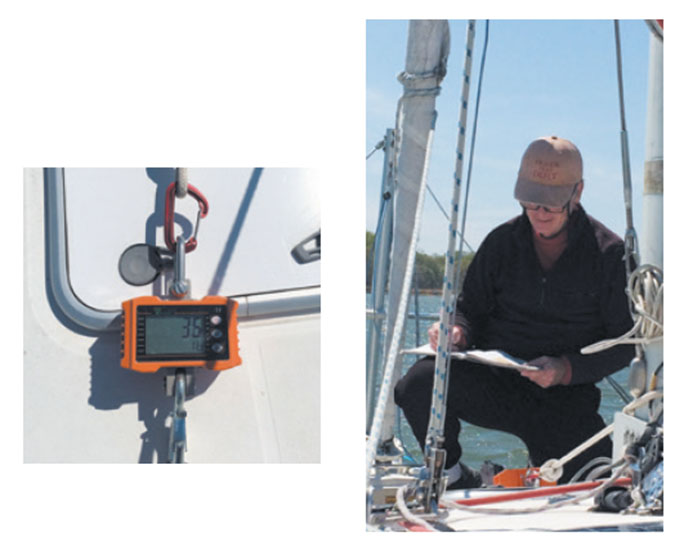
We rigged each of these sails on our test boat in a variety of winds. Using the boat’s compass and wind vane we measured the apparent yaw angle. A strain gauge was used to record any changes in rode tension. Due to the boat’s movement relative to the wind (some actually sail forward), the yaw angle, as measured, will not always reflect actual angle to the true wind. However, these two measurements are typically similar and always proportional in magnitude for any given boat. We also observed ease of rigging and the amount of flogging (if any).
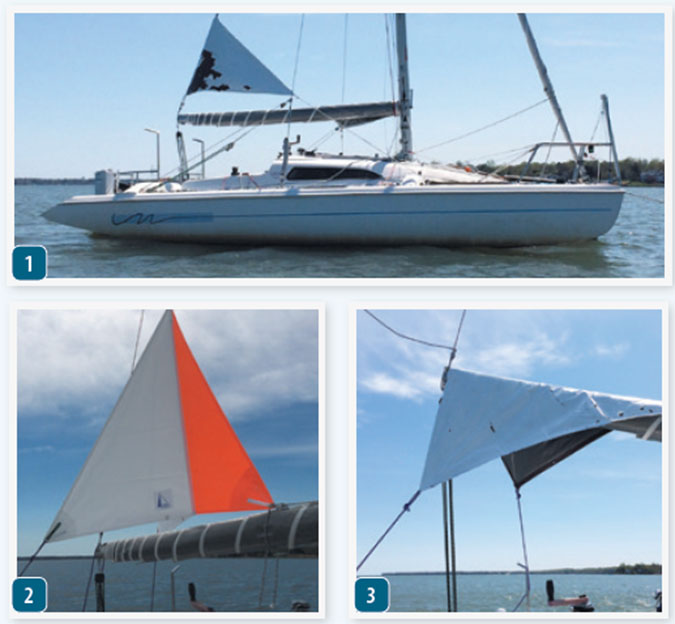
Generally, a boat with a high cabin that sails around a lot will need a larger size riding sail, while a more streamlined boat that is relatively stable will need less sail area. Relatively small sails can be surprisingly effective. We tested three different designs:
- A traditional triangular riding sail is hoisted on the backstay and sheeted to one side.
- The Fin-Delta from Banner Bay Marine forms a Y-shape, promising more efficient control.
- Even our cheap over-the-boom mockup made from a plastic tarp held up in 30 knots of wind.

































We anchor frequently in our Kadey Krogen 58. Yawing is scary in a 100,000# boat; we experienced ~ 60 degrees in a blow in Georgetown, Bahamas last year. ( In 15′ of water, I had out 175′ of 1/2″ chain; my snubber is 20′ of 3/4″ triple strand nylon connected to the bow eye at 2′ above the water) How do you suggest we install a riding sail on our boat? I have a mast. We use a 154# Rocna anchor and have a 154# Delta as backup Thanks, Scott Eason (account is under Melissa Eason)